|
Mabel Leclare Bullen (1886–1955) age seventeen
Mabel was the daughter of Frederick and Cora Landers
Bullen. Frederick owned a company that
produced malt for beer breweries. He would in
a few years also become an officer in a Mexico
plantation enterprise headed by George Sanborn,
father of party hosts Harold and Jean Sanborn (see
right). Five years
later Mabel married Herman F. Friestedt; the pair had
three sons and remained in Chicago throughout their
lives.
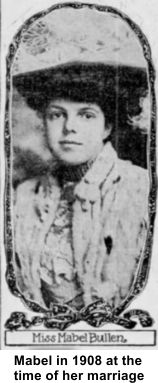
_________________
William B. Gaddis jr (1887–1966) age sixteen
Was a student at Lake Forest
in 1903. He badly injured his knee while
playing football, playing on the side of the
opposing team, Highland Park, who was short a few players.
He usually played left end but spent most of the
1903-4 year on crutches, in a
wheelchair or wearing a cast and finally had surgery
in Chicago. Can't imagine knee surgery in
1903. He was the son of William Henry Gaddis
and Isabella Sarver Gaddis. Twenty years later
he married Lucile Carpenter and they had three
children. He was president of Oak Lawn,
Illinois for a term and on the board of education.
In 1961 an elementary school was erected in his
name. Then seventy-four years old, William was
interviewed in conjunction with the school opening.
He said that parents brought the family to Oak Lawn
when he was five years old and he spent the next
sixty-nine years living in the 9600 block of S. Cook
Avenue. Either the newspaper was in error or
his memory was faulty because the 1930 U.S. Census
had he and his family living on Blackstone,
operating an electrical and battery shop (that
failed). (In the 1920s he worked as a salesman
in a coal dealership where he met his future wife,
niece of the owner.) The house on S. Cook was
not built until 1908. He worked for Chrysler
during World War II and after the war joined his
brother in an insurance and real estate business.
_________________
Augusta Greene (1886–1972) age seventeen
Augusta was from Spokane, Washington and a student
at Lake Forest College (below) where she was pledged
to the Sigma Phi sorority and president of her class. She was the
daughter of George and Fannie House Green. She
went on to attend the University of Washington.
In 1916 she married Charles A. Thatcher of Ohio with
whom she had one son; at Thatcher's death she
married Dr. Earl "Bert" Leatherman, also of Ohio.
_________________
Violet Hauford
Many
variations of the last name make this a difficult
find.
_________________
Fannie A. Mowry (1886–1972) age seventeen
Fannie was from Aurora, Illinois, west of Chicago,
in 1903 attending
Lake Forest College (also below) She was the daughter
of Dr. Christopher Dean Mowry and Fannie Alderman
Mowry. In 1909 she created a minor sensation
when she abruptly ended her engagement to a
prominent young attorney to marry her college
sweetheart, office supply salesman Lester Hale Raber
of Des Moines, Iowa. They would remain
together for the rest of their lives, raising three
children.
_________________
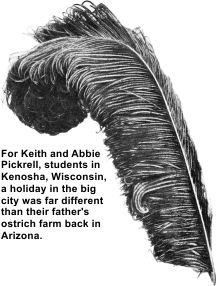
Abigail B. "Abbie" Pickrell (1887–1950) age sixteen
It was reported that Abbie and her brother Keith
(below) were students in Kenosha, Wisconsin.
Keith may have been in Kenosha but Abbie was at
Ferry Hall at Lake Forest College (below).
The Pickrell siblings were born in Nebraska but by
1900 the family lived in Arizona and operated an
ostrich farm. They were two of six children
born to William S. Pickrell and Georgiana Keith
Pickrell. Following their education both would
return to Arizona and spend their lives there, Keith
in Phoenix and Abbie in Flagstaff. She married
Charles W. Isham, a bookkeeper insurance man from
Cincinnati, and the pair had two children. She
outlived one of them.
_________________
John Kieth Pickrell (1885–1934) age eighteen
The brother of Abbie Pickrell (above) John was
reportedly a student at a school in Kenosha,
Wisconsin. If so, the school was probably the Kenosa
College of Commerce.
John's interview with newspapers (top image) provided
one of several glimpses of the audience in the
Iroquois auditorium from the first floor
perspective. Only a handful of first floor
occupants perished and amongst the survivors were
several staying at nearby hotels such as the
Sherman
House. Newspaper reporters soon gathered for
interviews, to use telephones and get out of the
cold.
See Abbie's section for information about their
parents.
John married a woman named Clara Sauer and became a
civil engineer in Arizona. A nephew, William
Smith Pickrell III, pioneered computers in the
petroleum industry to analyze oil exploration data
and oversaw the development of the first ATM
machines. He named a son after John.
_________________
Henry A. "Harry" Pridmore (1884–1931) age nineteen†
Harry was one of three children born to pattern maker and
inventor Henry E. Pridmore and Emily Hitchcock
Pridmore. His father founded Pridmore Molding
Machines Manufacturing at 19th & Rockwell in Chicago
and was reportedly one of the best known men in the
foundry business, with a national reputation as an
inventor. He invented his first molding machine in
1886 at the
McCormick Harvesting Machine Company and founded
his own firm in 1899. Son Harry would later
marry Frances Dewey, then Anna Hart and produce two
children.
|
 |
Grata Eugenia "Jean" Sanborn (1888–1968) age Fifteen
Though 1903/4 newspapers reported that Jean and her
brother Harold (below) were students in Kenosha, the
1903 Stentor annual at Lake Forest College in
Illinois (below) listed Jean as a resident of Ferry
Hall. A newspaper notice of a visit from Harold, suggests that he
may have remained at Kenosha while
Jean attended Lake Forest. The same may have
been true of Abbie and Keith Pickrell.
Jean and Harold were the children of George and Cora Sanborn
(right). In 1907 she married Louis A. Loew Jr.
of New York. the pair moved to Batopilas, Chihuahua,
Mexico where he had mining interests. In 1926
she married Edward A. Howard and spent her last
years in L.A. She bore at least two
children.
_________________
Harold C. "Hal" Sanborn (1885–1953) age eighteen
Harold was the son of George C. Sanborn and Cora
Allen Sanborn.
George Sanborn was the president of Sanborn Lumber
and Development, the Mexican Planters Association
and a member of the Board of Trade in Chicago.
Harold had graduated from Lewis Institute and in
December, 1903 was probably home for the holidays
while a student at Kenilworth Military Academy.
Three years later, at age twenty-two,
he was jailed for his involvement in the deaths of
seven* Mexicans during a gun battle.
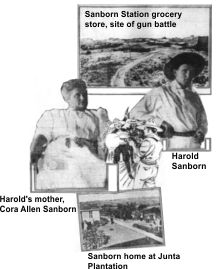
He was working as an assistant overseer at his father's
Junta Plantation, a division of the Mexican Mutual Plantation,
a 5,554-acre spread in La Junta near Vera Cruz. The
plantation farmed 458 acres of coffee, 3,298 acres
planted with 200,000 rubber trees and 126
acres containing 30,000 cacao trees.
The stripped-down story assembled from reports in
several dozen 1909 newspapers is that Harold
happened to be on the scene at a grocery on the
plantation, while wearing a pair of 38's he'd taken
to packing since being threatened by disgruntled
rubber tapper employees. The storekeeper had killed a nineteen
year old woman, Inez Ibarra, for having killed his
brother, a police officer employed by the
plantation. A mob of unknown size gathered and
gunfire ensued, with Harold drawing both guns — reportedly
in self defense after incurring a neck wound.
When it was over, seven people were dead.
Harold spent a month in custody before being bonded
out. His father hurried to the scene, spoke
to authorities, paid the bail, concluded all was resolved and
headed to his offices in New York. In NYC he went to have a cluster of boils lanced and bled to
death on the operating table. Unbeknownst to him,
his wife, Cora, was soon being held in Mexico as surety
for Harold's bond. Harold was accused of
killing Ibarra, despite a mismatch between the
caliber bullet that killed her and his 38s. A
former U.S. senator from Illinois,
Albert J. Hopkins, intervened with Mexican
authorities and secured Harold's exoneration.
George Sanborn left a $40,000 life insurance policy
that may have helped Harold purchase an
Overland auto dealership later in 1909, with a
trading territory in Boone and McHenry counties.
Something went amiss, however, and by 1910 he was unemployed. Hal
eventually married and had two children, one of whom
became a nun. He became an aviator during
World War I, achieving the rank of captain, though
I'm not sure he saw action, then
also served as a reservist during world war II, achieving the rank of
colonel. In the 1930s he tried his hand at
politics in California.
Mabel Bullen's father, Fred F. Bullen, was an officer in
Sanborn's Mexico Plantation.
_________________
Edward Albert Singer (1887–1848) age sixteen
Albert was the son of German immigrants, Dr.
Berthold "Herman" Singer and Anna Ebner Singer.
His sister, Fay/Fannie Singer, was a student at Lake
Forest (below) with Grata Sanborn, Augusta Greene, Fannie Mowry
and Abbie Pickrell.
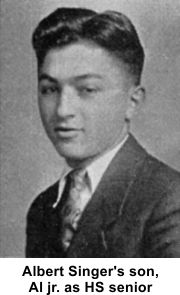
Five years after the Iroquois fire Albert traveled with
his family on a hopeless four-month quest to find
lifesaving treatment in Europe for his
fifteen-year-old sister Ada's tuberculosis.
She died on the return trip aboard the Kaiserin
Auguste Victoria steamship. Berthold Singer,
Albert's father, was the Spanish consul to Chicago
and the NW U.S. His appointment was made
official by the Queen Regent,
Maria Christina of Austria in November, 1901. He
had operated in that capacity unofficially for some
time, as well as for Costa Rica, Turkey and
Nicaragua. He was considered an authority on
patent, trademark and international law, authoring
several books in these fields.
In 1909 Albert married a California girl, Rose
Dahlstrom, and they had three children. After
living in New York and Los Angeles for a time they
settled in northwest Chicago, in the Barrington and
Cuba Lake area.
_________________
Percy James Taylor (1887–1957) age sixteen
Percy was a student at Lewis Institute and may
have been introduced to the others by Harold
Sanborn, who also attended Lewis.
He was the son of Bayard Taylor and Addie Dunn Taylor. After his
graduation from Lewis in 1906 Percy headed off to
Cornell where he received a degree in mechanical
engineering. He became a star on the track
team there, in 1909 breaking the intercollegiate
record for the 2-mile. Percy's younger
brother, Bayard Taylor jr., would follow Percy's
footsteps to Lewis Institute and Cornell.
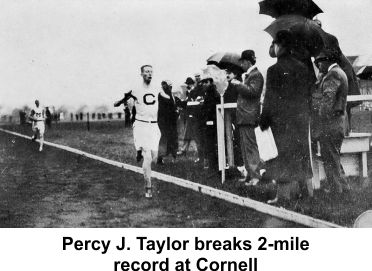
|
